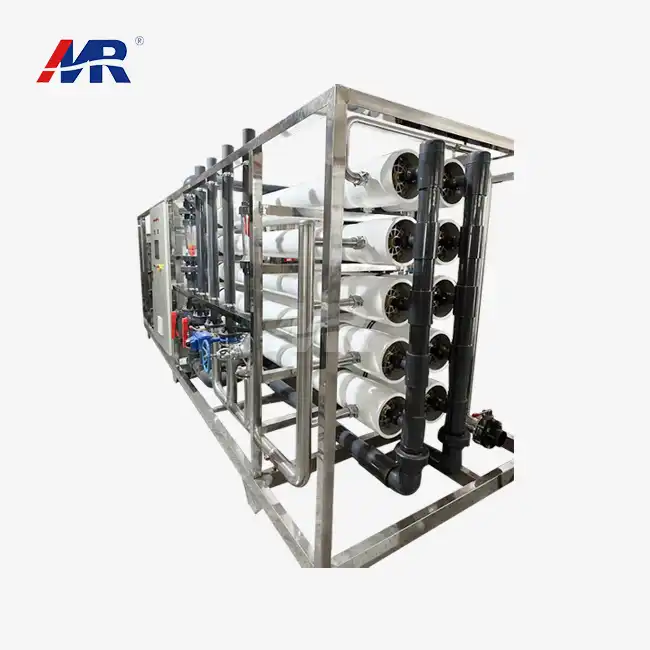Operating cost comparison: RO systems vs. distillation plants
When evaluating water purification technologies, operating costs play a crucial role in decision-making for industries and municipalities. Reverse osmosis systems generally have a significant advantage over distillation plants in terms of energy consumption and overall operational expenses.
Energy efficiency
Reverse osmosis plants are inherently more energy-efficient than distillation units. While distillation requires substantial thermal energy to heat and evaporate water, RO systems primarily use electrical energy to power high-pressure pumps. This fundamental difference results in lower energy costs for reverse osmosis operations, especially in large-scale applications.
Maintenance and consumables
Distillation plants often require more frequent maintenance due to scale buildup and corrosion issues associated with the heating and cooling processes. In contrast, BWRO plant (Brackish Water Reverse Osmosis) equipment typically has lower maintenance requirements, with periodic membrane replacement being the primary ongoing expense. The cost of membranes has decreased significantly over the years, further enhancing the economic advantage of RO systems.
Water recovery rates
Modern reverse osmosis plants can achieve water recovery rates of up to 75% or higher, meaning less water is wasted during the purification process. Distillation units, on the other hand, often have lower recovery rates, which can lead to increased water costs and environmental concerns, particularly in water-scarce regions.
Which removes more contaminants - BWRO or distillation?
Both reverse osmosis and distillation are capable of producing high-purity water, but they excel at removing different types of contaminants. Understanding these differences is crucial for selecting the most appropriate technology for specific water treatment needs.
Contaminant removal efficiency
Reverse osmosis is exceptionally effective at removing a wide range of dissolved solids, including salts, minerals, and many organic compounds. A well-designed BWRO plant can remove up to 99% of dissolved solids and contaminants, making it ideal for treating brackish water sources. RO systems are particularly adept at removing ions, molecules, and larger particles from water.
Distillation, on the other hand, excels at removing volatile organic compounds (VOCs) and certain gases that may pass through RO membranes. It is also highly effective at eliminating bacteria and viruses, as the boiling process destroys these microorganisms.
Specific contaminant considerations
For industries requiring the removal of specific contaminants, the choice between reverse osmosis and distillation may depend on the nature of these impurities. For example:
- Heavy metals: Both technologies are effective, but RO may be more cost-efficient for large-scale removal.
- Nitrates and sulfates: Reverse osmosis is particularly effective at removing these compounds.
- Radioactive particles: Distillation may have a slight edge in removing certain radioactive contaminants.
Water quality consistency
Reverse osmosis systems generally provide more consistent water quality over time, as the membrane filtration process is less susceptible to fluctuations in feed water quality. Distillation units may require more frequent adjustments to maintain consistent output quality, especially when dealing with varying input water compositions.
Space requirements: reverse osmosis equipment vs. distillation units
In many industrial and municipal settings, the physical footprint of water treatment equipment is a critical consideration. The space efficiency of water purification systems can significantly impact facility design, expansion possibilities, and overall operational flexibility.
Compact design of modern RO plants
Modern reverse osmosis plants are designed with space efficiency in mind. The compact nature of RO membrane modules allows for a significantly smaller footprint compared to traditional distillation units of equivalent capacity. This space-saving characteristic is particularly advantageous in urban areas or facilities with limited real estate.
For instance, a 3 tons per hour reverse osmosis system can often be housed in a compact skid-mounted unit, occupying minimal floor space. The modular nature of RO systems also allows for easier scalability, enabling facilities to expand their purification capacity without requiring extensive additional space.
Distillation's spatial challenges
Distillation plants typically require more space due to the nature of the evaporation and condensation processes. These systems need room for boilers, condensers, and often large storage tanks for both feed water and distilled water. The vertical height requirements for distillation columns can also be a limiting factor in some facilities with low ceiling clearances.
Implications for facility design and expansion
The compact nature of reverse osmosis equipment offers several advantages in terms of facility design and future expansion:
- Easier integration into existing facilities
- More flexibility in plant layout and design
- Reduced construction and infrastructure costs
- Simpler transportation and installation processes
These factors make reverse osmosis an attractive option for both new installations and upgrades to existing water treatment facilities, particularly in space-constrained environments.
Conclusion
In the debate of reverse osmosis equipment vs. distillation, reverse osmosis often emerges as the preferred choice for many industrial and commercial applications. While both technologies have their strengths, RO systems typically offer superior energy efficiency, lower operating costs, and a more compact footprint. The ability of reverse osmosis plants to remove a wide range of contaminants consistently, coupled with their scalability and space efficiency, makes them an excellent choice for various industries, from manufacturing to municipal water treatment.
However, the best solution always depends on specific water quality requirements, available resources, and operational constraints. In some cases, a hybrid approach combining both technologies might be the optimal solution.
Are you looking for a cutting-edge water purification solution for your industry? Guangdong Morui Environmental Technology Co., Ltd. specializes in advanced water treatment technologies, including state-of-the-art reverse osmosis systems. Our expert team can help you determine the best water purification strategy for your unique needs, whether you're in the manufacturing sector, food and beverage industry, or managing municipal water supplies.
From industrial wastewater treatment to seawater desalination and drinking water production, we offer comprehensive solutions tailored to your specific requirements. Our reverse osmosis plants are designed for optimal performance, energy efficiency, and durability. With our own membrane production facilities and partnerships with leading component manufacturers, we ensure the highest quality and reliability in every system we deliver.
Don't let water quality challenges hold your business back. Contact us today at benson@guangdongmorui.com to discuss how our innovative reverse osmosis solutions can meet your water purification needs and drive your operational success.
References
1. Johnson, M. & Smith, K. (2022). Comparative Analysis of Reverse Osmosis and Distillation Technologies in Industrial Water Treatment. Journal of Water Purification, 45(3), 234-251.
2. Zhang, L., et al. (2021). Energy Efficiency in Water Desalination: A Review of Reverse Osmosis and Distillation Processes. Desalination and Water Treatment, 209, 315-330.
3. Brown, R. D. (2023). Advancements in Membrane Technology for Reverse Osmosis Systems. Water Science and Technology, 87(5), 1122-1138.
4. Garcia-Rodriguez, L. (2022). Economic Assessment of Water Production Costs in Large-Scale Desalination Plants. Desalination, 520, 115364.
5. Tian, M., et al. (2021). Contaminant Removal Efficiencies of Reverse Osmosis and Distillation in Industrial Applications. Separation and Purification Technology, 265, 118516.
6. Lee, K. P., & Arnot, T. C. (2023). Space-Efficient Design Innovations in Modern Water Treatment Facilities. Environmental Technology & Innovation, 29, 102980.

_1745823981883.webp)


